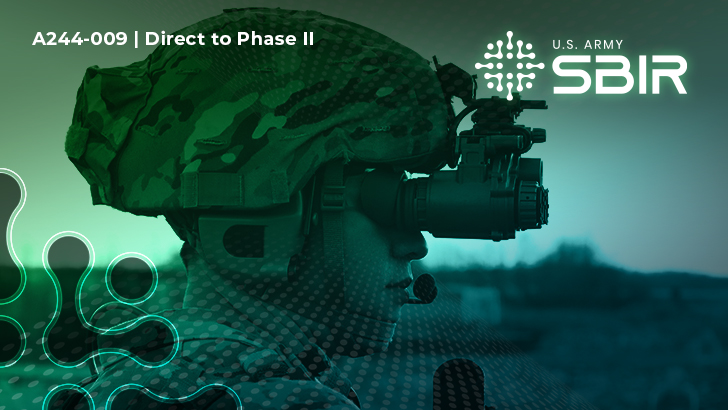

Direct to Phase II Selectees
Objective
The Army seeks to develop dual-band Mid-wave Infrared/Long-Wave Infrared (MWIR/LWIR) Infrared Focal Plane Array (IR FPA) technology that can meet Third Generation Forward Looking Infrared performance objectives, such as clusters, dark current, noise, quantum efficiency, operability, spectral crosstalk, modulation transfer function and non-uniformity correction stability.
This project benefits various Army and Department of Defense night vision sensors, including individual Soldiers, ground vehicles, unmanned vehicles and aircraft that use dual-band thermal sensors. The combination of MWIR and LWIR imaging increases the ability to penetrate fog and dust clouds and provides resilience against stray light artifacts from bright sources. Image fusion between the spectral bands also enhances target detection.
Description
While the Mercury Cadmium Telluride (HgCdTe) supplier is the incumbent detector material system for advanced sensors, the sector has made remarkable progress in the electro-optical performance of IR FPAs, which consist of an Antimonide-based strained layer superlattices (SLS). This progress drove the adoption of sensors based on IR FPAs for fielded systems.
Presently, the HgCdTe supplier has yield problems regarding stringent detector specifications, which the SLS can solve. A cost-effective and high-yield new detector material will provide broad benefits to the Army and DoD for maintaining the dominance of electromagnetic spectrum on the battlefield, particularly in the domain of thermal infrared imaging. The innovative approach of using SLS detectors to solve high-volume, high-performance night vision imaging systems will be a game changer for the new class of ground and airborne systems.
Foundries can make the material for the SLS at a lower expense compared with the dedicated, specialized growth equipment needed for 2-6 HgCdTe material. The spatial uniformity of the SLS material is far superior to the HgCdTe material and results in a higher Detection, Recognition and Identification (DRI) range for the infrared system than what is possible with the older material.
Phase I
The solicitation is a Direct to Phase II effort.
Phase II
Phase III
The technology’s dual-use potential centers around infrared applications that require high sensitivity, detection range, and a capture rate enabled by cooled-infrared, focal-plane array technology, like SLS detectors.SLS detectors have cost, fabrication, and performance advantages over the incumbent cooled IR FPA of choice, HgCdTe, but still have higher cost and cooling requirements than uncooled IR FPAs. Market applications for SLS-enabled infrared optics could potentially include:
Submission Information

References:
Direct to Phase II Selectees
Objective
The Army seeks to develop dual-band Mid-wave Infrared/Long-Wave Infrared (MWIR/LWIR) Infrared Focal Plane Array (IR FPA) technology that can meet Third Generation Forward Looking Infrared performance objectives, such as clusters, dark current, noise, quantum efficiency, operability, spectral crosstalk, modulation transfer function and non-uniformity correction stability.
This project benefits various Army and Department of Defense night vision sensors, including individual Soldiers, ground vehicles, unmanned vehicles and aircraft that use dual-band thermal sensors. The combination of MWIR and LWIR imaging increases the ability to penetrate fog and dust clouds and provides resilience against stray light artifacts from bright sources. Image fusion between the spectral bands also enhances target detection.
Description
While the Mercury Cadmium Telluride (HgCdTe) supplier is the incumbent detector material system for advanced sensors, the sector has made remarkable progress in the electro-optical performance of IR FPAs, which consist of an Antimonide-based strained layer superlattices (SLS). This progress drove the adoption of sensors based on IR FPAs for fielded systems.
Presently, the HgCdTe supplier has yield problems regarding stringent detector specifications, which the SLS can solve. A cost-effective and high-yield new detector material will provide broad benefits to the Army and DoD for maintaining the dominance of electromagnetic spectrum on the battlefield, particularly in the domain of thermal infrared imaging. The innovative approach of using SLS detectors to solve high-volume, high-performance night vision imaging systems will be a game changer for the new class of ground and airborne systems.
Foundries can make the material for the SLS at a lower expense compared with the dedicated, specialized growth equipment needed for 2-6 HgCdTe material. The spatial uniformity of the SLS material is far superior to the HgCdTe material and results in a higher Detection, Recognition and Identification (DRI) range for the infrared system than what is possible with the older material.
Phase I
The solicitation is a Direct to Phase II effort.
Phase II
Phase III
The technology’s dual-use potential centers around infrared applications that require high sensitivity, detection range, and a capture rate enabled by cooled-infrared, focal-plane array technology, like SLS detectors.SLS detectors have cost, fabrication, and performance advantages over the incumbent cooled IR FPA of choice, HgCdTe, but still have higher cost and cooling requirements than uncooled IR FPAs. Market applications for SLS-enabled infrared optics could potentially include:
Submission Information
References:
